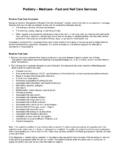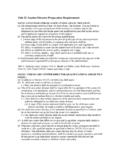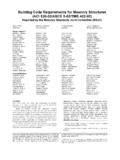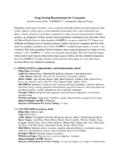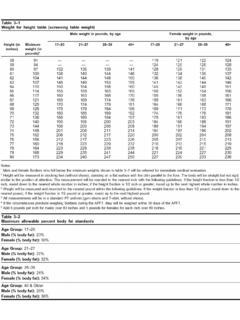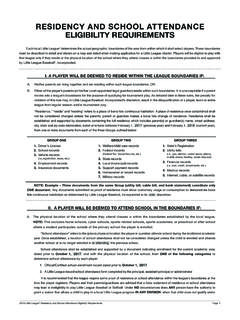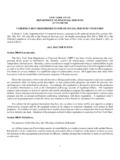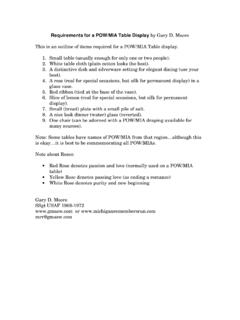Transcription of Chiropractic - Documentation Requirements 101
1 Chiropractic - Documentation Requirements 101. There are a few basic things everyone needs to know about Documentation . It is a requirement that you keep proper records on your patients. It is easy to get done and doesn't need to be a nightmare; it actually might be fun to do. It can and should be done on a timely basis. You should complete a note for every patient, every visit. If you touch your you should touch your note. It doesn't matter if the visit is insurance, wellness, or document the visit. Keeping proper Documentation is your protection! What type of protection does Documentation offer for your practice? Protection against Medicare audits and insurance company audits. Protection against all sorts of medical/legal issues. Protection against catastrophic loss (fire, storms, thefts, etc).
2 Protection against lost revenues. Protection against charting and billing errors. Documentation Requirements (ACA). Subjective, Objective, Assessment and Treatment/Plan (if rendered) components should be incorporated into patient records on each visit. A customized format is not needed but these elements must exist consistently. Any significant changes in the clinical picture ( significant patient improvement or regression) should be noted. All ICD-9-CM diagnosis codes and CPT treatment and procedure codes must be validated in the patient chart and coordinated as to the diagnoses and treatment code descriptors. Uniform Chiropractic language should be used within the profession for describing care and treatment. Non-standard abbreviations and indexes should be defined. Documentation for the initial (new patient) visit, new injury or exacerbation should consist of the history and physical and the anticipated patient treatment plan.
3 The initial treatment plan, except in chronic cases, should not extend beyond a 30-45 day interval. Subsequent patient visits should include significant patient improvement or regression if demonstrated by the patient on each visit. As the patient progresses, the treatment plan needs to be reevaluated and appropriately modified by the treating doctor of Chiropractic ( Chiropractic physician) until the patient can be released from care, if appropriate. If the patient is disabled, a statement(s) on the extent of disability and activity restriction is needed at initial and subsequent visits as appropriate over the course of care. All records must be legible and understandable, released within the authority given by the patients, in a secure, confidential manner and in compliance with existing state (or federal) statutes.
4 The patient name and initials of the person making the chart notation (especially in multi-practitioner offices) should appear on each page of the medical record. Initial Visit Requirements : Relevant History of Patient's Condition with Detailed Description of the Present Condition Evaluation of Musculoskeletal/Nervous System through Physical Examination Diagnosis Treatment Plan Recommended Duration and Frequency of Visits (3x per week for a period of 4 weeks). Specific Treatment Goals Functional Limitations Activities of Daily Living (ADL). Date of Initial Treatment Subsequent Visit Requirements : History Review of Chief Complaint Improvement or Regression since last visit Patient Specific Comments Follow-up of ADL's. System Review, if relevant. Physical Examination Documentation Requirements (CMS).
5 Under the policies developed by Medicare, coverage of Chiropractic services is specifically limited to "manual manipulation of the spine to correct a subluxation". The subluxation is defined as a motion segment in which alignment, movement integrity, and/or physiological function of the spine are altered although contact between joint surfaces remains intact. Therefore, you must document in your patient's physical examination, their initial chart notes, and subsequent chart notes that you are indeed treating a subluxation. Unless this subluxation is properly documented, medical necessity has not been established and claims may be rejected by Medicare. Utilization guidelines for Chiropractic services require the following 3 components to establish medical necessity: 1. Presence of a Subluxation.
6 Subluxation causes a significant neuromusculoskeletal condition. Medicare will not pay for treatment unless by manual manipulation of the spine to correct a subluxation. Subluxation must be consistent with the complaint/condition. 2. Documentation of the Subluxation. A subluxation may be demonstrated by one of two methods: X-ray or Physical Examination. If documented by the physical exam, the PART system must be used. 3. Documentation of the Initial and Subsequent Visits. Specific Documentation Requirements apply whether the subluxation is demonstrated by x-ray or by physical examination. Demonstrating Subluxation with Physical Exam using PART: At least two (2) of the following four (4) components must be documented, and at least one must be either Asymmetry/Misalignment (A) or Range of Motion Abnormality (R).
7 P - PAIN AND TENDERNESS. Observation: You can document, by personal observation, the pain that the patient exhibits during the course of the examination. Note the location, quality, and severity of the pain Percussion, Palpation, or Provocation: When examining the patient, ask them if pain is reproduced, such as, Let me know if any of this causes discomfort.. Visual Analog Type Scale: The patient is asked to grade pain on a visual analog scale from 0-10. Audio Confirmation: The patient is asked to verbally grade their pain from 0-10. Pain questionnaires: Patient questionnaires, such as the McGill pain questionnaire or an in-office patient history form, can be used for the patient to describe their pain. A - ASYMMETRY/MISALIGNMENT. Observation: You can observe patient posture or analyze gait.
8 Static and Dynamic Palpation: Describe the spinal misaligned vertebrae and symmetry. Diagnostic Imaging: You can use x-ray, CAT scan and MRI to identify misalignments. R - RANGE OF MOTION ABNORMALITY. Observation: You can observe an increase or decrease in the patient's range of motion. Motion Palpation: You can record your palpation findings, including listing(s). Be sure to record the various areas that are involved and related to the regions manipulated. Stress Diagnostic Imaging: You can x-ray the patient using bending views. Range of Motion Measuring Devices: Devices such as goniometers or inclinometers can be used to record specific measurements. T - TISSUE, TONE CHANGES. Observation: Visible changes such as signs of spasm, inflammation, swelling, rigidity, etc. Palpation: Palpated changes in the tissue, such as hypertonicity, hypotonicity, spasm, inflammation, tautness, rigidity, flaccidity, etc.
9 Can be found on palpation. Use of instrumentation: Document the instrument used and findings. Tests for Length and Strength: Document leg length, scoliosis contracture, and strength of muscles that relate. Practical Documentation - Patient History E/M. Doctors of Chiropractic are among a small group of providers authorized to use the evaluation and management (E/M). code set. Chiropractors use the Chiropractic manipulative treatment codes (CMT) for routine visits. These include a component of E/M in the value. The E/M code set is perhaps one of the most underused in the profession. There are many times when it's most appropriate to use an E/M code in addition to a CMT code in patient encounters, such as new patient visits, re- evaluations to determine if a change in treatment plan is necessary, new injuries, reinjuries, exacerbations, and others.
10 Documentation is the key to showing medical necessity of using these codes. One of the most important components to E/M coding and Documentation is History. The initial history taken from a new or returning patient sets the tone for the entire case. This is not the time to skimp on details, paperwork, or your evaluation. Information obtained in the history guides and directs you in understanding the needs of your patient; it also helps direct the treatment plan. Let's explore the Documentation Requirements for the history section of the E/M code set, and unravel the pieces of the puzzle to ensure you are gathering all you need to establish medical necessity for your care. History Components: Chief Complaint (CC). History of Present Illness (HPI). Review of Systems (ROS). Past, Family, Social History (PFSH).
